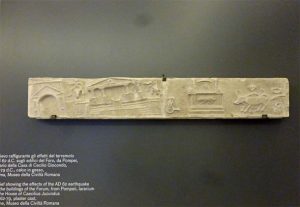After being used as décor, a stolen Pompeii artifact is recovered after fifty years.

A marble relief from the ancient city of Pompeii, believed to have been stolen, has been found in Belgium. This piece, dating back to around 62 AD, intricately portrays the devastating earthquake that befell Pompeii in the same year, capturing a moment of history, with the city’s gates crumbling.
Rediscovery in Belgium: A Pompeian Marble Relief Unearthed
The discovery was made in Herzele, East Flanders, at the home of Raphael De Temmerman and his son, Geert De Temmerman, who recounted the story of the artifact’s journey into their family’s possession.
During a 1975 holiday in Italy, they acquired the marble relief from an unidentified individual near Pompeii, installing it in their home as a decorative piece, unaware of its historical value.
The family’s recent plan to sell their house led to curiosity about the marble’s worth, prompting them to consult experts. This brought them to the Gallo-Roman Museum in Tongeren, where the piece’s true origin was astonishingly revealed.

Spectacular 2000-Year-Old Pompeii Food Stall Reopens for Business!
The Lupanare: Prostitution and Houses of Pleasure in Ancient Pompeii
The full-length marble relief, which depicts the Pompeii earthquake. (de Temmermans/ArchaeologyMag)
A Connection to Pompeii’s Past
Bart Demarsin, head of exhibitions at the museum, identified the artifact as a matching piece to another depiction of the Pompeii earthquake. Both were part of a Pompeian banker’s house over two thousand years ago.
Geert De Temmerman described the moment when the relief was authenticated:
“When they started shining a flashlight on it, I heard them exclaim, ‘Yes, it’s genuine,’ and they nearly fell over.”
The marble relief, missing since July 14th, 1975, represents a significant find for Pompeii’s cultural heritage. An Christiaens, Tongeren’s deputy mayor of culture, emphasized its importance, noting, “It is the cultural heritage from Pompeii, and it belongs there.”
Plans are in motion to return the piece to Pompeii’s Antiquarium, joining its counterpart after further validation of its authenticity.
Earthquake, Not Volcano, Claimed Many Victims In Pompeii
Evidence Suggests an Underground of Roman Sorcery in Pompeii
The Pompeii Earthquake of 62 AD
Pompeii, near Naples, was famously destroyed by the volcanic eruption of Mt Vesuvius in 79 AD but it had already suffered much structural damage before then due to earthquakes associated with its proximity to the volcano.
Supposedly on 5 February AD 62, an earthquake of an estimated magnitude of between 5 and 6 had struck, described as having aftershocks occurring for several days. An account of this was written by Seneca the Younger, a contemporary dramatist, but the actual year is uncertain, with different accounts placing it variously as 62 or 63 AD. At this time, even the cause of earthquakes was unknown, and Seneca devoted the sixth book of his treatise ‘ Naturales Quaestiones’ to the subject, reaching the incorrect conclusion they were caused by movements of air.
Representations of the earthquake have been found in other Pompeii properties, including one showing the destruction of the Temple of Jupiter, found in the still standing ‘House of Lucius Caecilius Iucundus’, on what is now called the Via Stabia.

Bas-relief showing the damage to Pompeii’s Temple of Jupiter during the earthquake, from the lararium of the House of Lucius Caecilius Iucundus. (CC BY-SA 4.0)
Investigating the Journey: How the Artifact Reached Belgium
Local police have initiated an inquiry into the artifact’s unexpected appearance in the De Temmerman residence. Amidst this, the family hopes for potential compensation, considering the artifact’s long undisturbed presence in their home. Geert De Temmerman remarked, “The judicial police told us we might still be able to get compensation. After all, the piece hung here for 50 years without anything happening to it. It could so easily have been sold on or broken.”